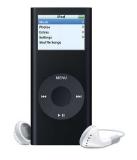iPod Nano Second Generation
![]()
![]()
![]()
![]()
![]()
![]()
![]()
![]()

Having given the matter considerable thought, I find myself wholly comfortable with an iPod that plays music and a cell phone than rings when someone wants to talk to me. Combining the two seems about as sensible as attaching a blender to a rhinoceros.
The second generation iPod Nano is unquestionably the best portable music device available in this half of the galaxy – aside from its truly ludicrous price, I can’t imagine buying anything else. That price is a bit of a kick, however – a four gigabyte iPod like the one we got lists at $199. Players with less cool names are available for half this.
The justification for crushing your plastic and buying an iPod is that they work really, really well, and they’re very easy to use. Small, light and intuitive, iPods make most other music players look like bricks with headphones.
One of the features of the iPods that its creator, Apple Computers, makes a lot of noise about is the iPod’s ability to play music purchased from iTunes, Apple’s on-line music store. I should mention that I’ve never done so. All my iPods have been loaded with MP3 files ripped from CDs I own. iPods are extremely good at managing this as well, although you have to imagine the suits at Apple sulking when they’re asked to do so.
I should also point out that the software that uploads music to an iPod – or “synchronizes your iPod with your music library,” as Apple’s documentation describes the process – is also called iTunes. It’s so named because it’s the same software that Apple provides to drive its on-line store. This doesn’t mean you have to buy any music from Apple if you don’t want to.
iTunes is available for both Macintosh and Windows platforms. As the only Macintosh we have at the moment has a geranium growing in it, this review pertains to iTunes running under Windows XP.
Unlike larger and more expensive iPods that can store a lot of video, the iPod Nano doesn’t have an internal hard drive. It stores its music in flash memory. A four gigabyte iPod Nano can store about three days worth of music, depending on how you compress it.
You can’t really use an iPod Nano without a computer running iTunes. The latter is how music gets onto an iPod, and how you can configure and maintain your iPod. Plugging an iPod into your computer’s USB port also charges its batteries.
Connected to headphones, a second generation iPod Nano will play for something approaching 24 hours between charges. This is about double what a first generation iPod Nano could manage.
Potential iPod owners will probably want to keep in mind that the battery in an iPod Nano can survive a finite number of charging cycles, and once it closes its tired little eyes for the last time, you’ll have to ship your iPod and 65 dollars to Apple to get the battery replaced.
The second generation iPod Nano offers a number of changes over its earlier predecessor. The most obvious of these is its single-piece aluminum case, which is considerably more robust and durable than the stamped metal cases of first generation iPod Nanos. This should keep the internal workings of your iPod safer, and less likely to be damaged by rough handling.
The least obvious of the changes to the second-generation iPod Nano is a slight adjustment in the locations of its headphone jack and data port, which makes it incompatible with a great many accessories designed for the first-generation iPod Nano. If you have any first-generation iPod accessories, buying a second generation iPod may require that you replace them.
Unlike the first generation iPod Nano, this latest incarnation of the iPod doesn’t come with iTunes on a CD-ROM. You’ll need to download it from Apple’s web page to use your new iPod. This arguably isn’t much of an issue, as the CD-ROM version that shipped with first generation iPods was invariably out of date by the time it actually got installed.
The iTunes software is a free download.
It would be difficult not to like the latest iPod Nano – all the more so if you’ve done battle with lesser music players in the past. The wealth of available third-party hardware to extend its capabilities makes it all the more attractive. Its capacious price may well be an affirmation that you get what you pay for.
It’s as cool as anything with circuitry inside is likely to get.